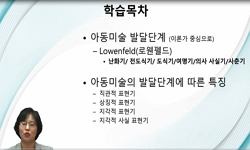본 연구는 노자 철학의 예술 사상을 담은 허(虛)와 정(靜) 개념에 내포된 미의식을 노자(老子) 에 서술된 문장 독해를 통해 고찰하고, 이에 맞닿은 미술 교육적 성격을 이론적으로 모색한 것...
http://chineseinput.net/에서 pinyin(병음)방식으로 중국어를 변환할 수 있습니다.
변환된 중국어를 복사하여 사용하시면 됩니다.
- 中文 을 입력하시려면 zhongwen을 입력하시고 space를누르시면됩니다.
- 北京 을 입력하시려면 beijing을 입력하시고 space를 누르시면 됩니다.

노자의 허(虛)ㆍ정(靜) 개념에 관한 미술교육적 접근 = A Study on the Lao-tzu's Aesthetic Thought from the Concept of XuJung and Educational Implications for Art Education
한글로보기https://www.riss.kr/link?id=A105807137
- 저자
- 발행기관
- 학술지명
- 권호사항
-
발행연도
2014
-
작성언어
-
- 주제어
-
KDC
607
-
등재정보
KCI등재
-
자료형태
학술저널
-
수록면
101-121(21쪽)
- 제공처
-
0
상세조회 -
0
다운로드
부가정보
국문 초록 (Abstract)
본 연구는 노자 철학의 예술 사상을 담은 허(虛)와 정(靜) 개념에 내포된 미의식을 노자(老子) 에 서술된 문장 독해를 통해 고찰하고, 이에 맞닿은 미술 교육적 성격을 이론적으로 모색한 것이다. 노자는 우주 만물의 근원과 이치를 도(道)로 보고 도에 이르는 핵심 개념으로 허(虛)와 정(靜) 개념을 제시한다. 허(虛)는 어떤 것을 인위적으로 취하고자 하는 욕심을 완전히 비우는 것을 말하고, 정(靜)은 어지러운 생각을 가라앉혀 마음을 고요히 만드는 것을 의미한다. 노자는 허정한 마음 상태에서 자연성이 발휘되고 만물이 서로 말미암아 상응하는 삼라만상의 근본을 깨닫는 도(道)에 이를 수 있다고 보았다. 본 연구는 노자의 도와 허정개념에 관한 의미를 노자(老子) 에 드러난 문장을 통해 탐색하고 허정개념에 내포된 미의식을 '무위자연의 미'와 '심물상응의 미'로 정리하였다. 무위자연의 미는 이성적 관념 및 인위성과 욕심을 버린 상태에서 고졸하고 담백한 상태로 드러나는 본질을 담은 미이다. 심물상응의 미는 인식 자아 중심적 표현이 아니라 인간과 미적 대상 두 존재가 동등한 존재론적 관계를 주고받으며 상응의 상태에서 형성되는 존재론적 성격의 미를 의미한다. 이러한 미의식은 현대 철학의 존재론적 사유와 상통한다. 허정 개념에 담긴 노자 미의식 탐구를 통해 본 연구자는 한국 미술 교육이 보완해야 할 방향으로 이성 중심 관점주의로부터 벗어나기, 허정지심의 마음 경험을 통한 존재 생성 체험하기, 나 중심의 표현에서 타자 존재 표현으로 확장하기, 인위와 기교를 비우고 다양성과 무법을 실험하기로 제안하였다.
다국어 초록 (Multilingual Abstract)
The purpose of this study is to examine Lao-tzu's aesthetic thought by searching for the concept of XuJung(虛靜) within the book Lao-tzu(老子), Tao Te Ching(道德經). Going a step further beyond this examining, this study tries to present some p...
The purpose of this study is to examine Lao-tzu's aesthetic thought by searching for the concept of XuJung(虛靜) within the book Lao-tzu(老子), Tao Te Ching(道德經). Going a step further beyond this examining, this study tries to present some practical educational implications for art education in this age. Lao-tzu thinks the basic principle of universe created is Tao(道). Tao has no specific shape but freely works on all things. In Tao, Ziran(自然), Wu(無, nothingness) and Wuwei(無爲) are considered crucial characteristics for Being promoted and created in the world. Lao-tzu also thinks human being can reach the state of Tao(道) through the concept of XuJung(虛靜). Xu(虛) is void without any intentional ego-conscioussness, stereotype and prejudices of human being. Jung(靜) is the state of tranquility without any agitation. This study summarized Lao-tzu's aesthetic thought involving in the concept of XuJung are beauty of Wuwei-Ziran(無爲自然) and beauty of Xīnwù-Xiāngyìng (心物相應). Beauty of Wuwei-Ziran is essential beauty of the Being without artificial greed and beauty on Xīnwù-Xiāngyìng is ontological beauty created between human being and aesthetic objects. To this end, this study suggest art education has to put in considerable efforts as follows: emerging from the rational perspective moral philosophy, experiencing the mind of XuJung in nature, enlarging art educational meaning toward the others expressions, embracing and applying various artistic attempt without artificiality.
목차 (Table of Contents)
- 요약
- Ⅰ. 들어가는 말
- Ⅱ. 노자 철학의 허(虛)ㆍ정(靜) 개념에 담긴 예술 사상
- Ⅲ. 노자의 허(虛)ㆍ정(靜) 개념을 통한 미술교육적 함의
- Ⅳ. 맺는 말
- 요약
- Ⅰ. 들어가는 말
- Ⅱ. 노자 철학의 허(虛)ㆍ정(靜) 개념에 담긴 예술 사상
- Ⅲ. 노자의 허(虛)ㆍ정(靜) 개념을 통한 미술교육적 함의
- Ⅳ. 맺는 말
- 참고문헌
- Abstract
동일학술지(권/호) 다른 논문
-
화육법(畵六法)에 기초한 전통미술 수업 사례 - 응물상형(應物像形), 수류부채(隨類賦彩), 경영위치(經營位置)를 중심으로 -
- 한국미술교육학회
- 정윤희
- 2014
- KCI등재
-
- 한국미술교육학회
- 이모영
- 2014
- KCI등재
-
- 한국미술교육학회
- 이미정(Lee Mi jeong)
- 2014
- KCI등재
-
- 한국미술교육학회
- 박미진(Park Mee Jin)
- 2014
- KCI등재




 스콜라
스콜라






